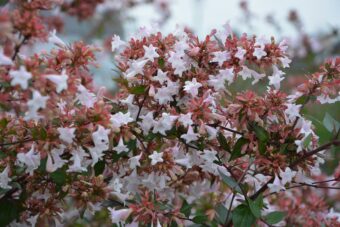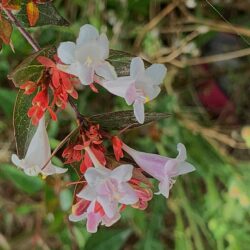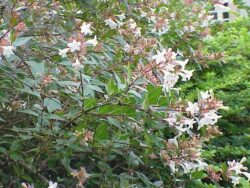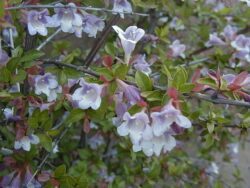In this article, we will discuss how to grow the beautiful flowering shrub of Abelia in containers. Abelia is an old genus, no longer recognised by botanists, which contains around 30 species belonging to the Caprifoliaceae (the honeysuckle) family.

Some botanists think it should be included in the Linnaea genus, excluding Zabelia which was raised to its own genus. The problem is that not all Botanists accept this and to this day, you will see Abelia sold in shops, whilst Linnaea is not listed as a synonym by most suppliers.
The shrubs of Abelia are native to Asia (especially Japan and the Himalayas) and to Mexico. In warm climates the shrubs are evergreen but in the UK they will be deciduous. The leaves are normally, dark, glossy green, opposite in nature or in whorls of three. The leaves can take a purplish-red hue in autumn in deciduous species.
They are not grown for the leaves but for the trumpet-shaped flowers that are produced from June to September. What makes it unusual amongst shrubs is that the reddish sepal remains even if all the petals have fallen. The flowers are often scented as well.
If you grow Abelias in containers, please go for the smaller species that grow less than 2m high, as the taller ones will need bigger containers.
GROWING ABELIA IN CONTAINERS
You will need to buy garden-ready species in spring, which is the best time to plant them. You will need to choose a container that is twice the size of the root ball of the Abelia you bought in the shop. Make sure whatever you use it has plenty of drainage holes at the bottom. The container can be made from any material (terracotta, plastic, stone etc.) as long as it suits the plant in question.

Abelias need to be free-draining as they do not like too much moisture at the roots. To aid drainage further add a 2cm layer of gravel at the bottom to allow excess water to escape. On top of this, add a growing media made by mixing 80% by volume of multipurpose compost with 20% by volume of perlite to make a well-draining growing media. To this growing media to give your plant an initial boost, you can add a handful of fish, blood or bone or growmore to get it going.
To the centre of the container, dig a hole that is slightly bigger than the root ball in the original container. Place the plant in so that the top of the root ball is at the same level as the top surface of the compost. Backfill the plant using the growing media so that no gaps remain, using more compost if necessary. Firm the plant in and water well.
BEST GROWING CONDITIONS
Abelias like to grow in full sun, as in the shade, they will not do as well. No matter where you place the container, make sure it is protected from cold winds and harsh weather. You will need to keep a close eye on your shrub until it is well established, which can be a year. Gauge how your plant is doing and if it seems to be struggling then you should move it. Remember as the shrub is big and the weather can be hot, it will need plenty of water to do well.
This is one plant that needs moisture but at the same time, it does not like its feet wet. When 5cm below the top surface of the compost feels dry to the touch it is time to water. Check your container regularly.

You will need to fertilize your Abelia regularly, especially when it is in bloom. Use a high potash liquid fertilizer such as Phostrogen to get it through the growing season. In early spring, you can alternatively give a slow-release fertilizer to give enough nutrients to last the growing season.
Some species are hardier but others are tender and may require the protection of a greenhouse to survive. It is best to check what the label says before you decide on what species to buy.
Abelia does not need to be pruned at all but if it is looking straggly or any branches are damaged then you can cut them out in May.
To propagate, you can take semi-ripe cuttings during the summer and place them in a cold frame. Once the cuttings have taken and established, you can plant them out next year.
PESTS AND DISEASES
Abelia seems to be resistant to most pests, although they may suffer from aphids. This is best dealt with by blasting them with jets of water or if really bad with a suitable systemic insecticide. If terms of diseases the plant seems to be very resistant and so should do well in with a UK climate.
VARIETIES TO GROW
The main species to grow is Abelia x grandiflora, which has arching branches with shiny leaves and a continuous display of flowers between July and September. Varieties include ‘Francis Mason’ which produces pink, tubular blooms with a honey scent growing up to 1.5m high. ‘Kaleidoscope’ produces white, lightly fragrant blooms growing up to 75cm high. ‘Sparkling Silver’ has green-silver, pink-tinged leaves and produces rosy-pink flowers and grows up to 90cm high. ‘Sunny Charm’ produces butter-yellow flowers with pink blotches. This 1.2m tall shrub is one of the most fragrant of all the Abelias.

Abelia chinensis produces white flowers that are flushed pink and are borne from midsummer to early autumn. It grows up to 1.7m tall. ‘Edward Goucher’ produces lilac-pink flowers and has greyish-green leaves. It is also reasonably hardy.
‘Pinky Bells’ produce pink bell-shaped flowers that are huge and it is a semi-evergreen plant. The leaves turn a fiery red in autumn and grow up to 90cm in height,
More tender species include A. floribunda which produces cherry red flowers in June and grows up to 1.5m high. A short species is A. schumannii which grows up to 1.2m tall and has lilac-pink flowers.
CONCLUSIONS
In this article, we have discussed how to grow the beautiful shrub of Abelia in containers. This is one shrub that not only looks good but is often scented at the same time. They are, in general, easy to care for and look after, not even requiring much pruning unless it is necessary. You have plenty of choice of what variety to grow and you will soon have a beautiful shrub in your garden.
If you have any questions or comments that you wish to make on growing Abelia in containers, please do so in the comment box below.
Happy Abelia growing.
